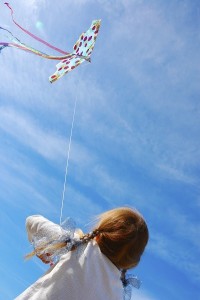 Click here for a printer-friendly version of this page.
Click here for a printer-friendly version of this page.
Objective You’re going to build on the Flying Machines concepts by building larger airfoils called Kites. The goal is to get them even more excited about fluid mechanics and aerodynamics by building projects that really fly. We’re going to continue learning about air pressure and Bernoulli’s law through the different kite designs. The first thing to do is watch the video on the Kites website page, and then dive into the experiments.
Main Ideas While the kids are playing with the experiments see if you can get them to notice these important ideas. When they can explain these concepts back to you (in their own words or with demonstrations), you’ll know that they’ve mastered the lesson.
- Higher pressure always pushes.
- The faster air travels over a surface, the less time it has to push down on that surface and create pressure. Fast moving air creates low pressure regions. (Bernoulli’s Law).
- The four fundamental forces on a kite are lift, weight, thrust, and drag. (The thrust is the pull on the string, and the lift occurs when wind flows over the top and bottom of the kite.)
About the Experiments The experiments in this section will take more time to put together, as you are building several different kite designs, including the box kite, the dragon, the diamond, and the rotor kite. If your kite doesn’t take off immediately, ask your child how it doesn’t work… did the nose tip over, did it spin, flip, or just tumble? Asking better questions is one of the key ingredients to making a great a scientist. Focus on watching what happens when you make small changes, and try to change only one thing at a time.
Before flight, hold your kite where the main line attaches to the bridle (the part that attaches to the string spool). Adjust the strings so that the kite hangs about 30 degrees into the wind. Use your fingers on the bridle on a windy day to find the “magic spot” or the place where your kite picks right up and flies best.
Moving the bridle forward makes the kite fly higher in smooth winds and moving it backward helps it fly in gusty winds. If your kite fails to rise, try a windier spot or a shorter tail. If it flies then quickly crashes, you may need to shorten your bridle or change the angle. If your kite spins around and around while flying, add more tail length.
The How and Why Explanation Kites are airplanes on a string. They use both high and low pressure to gain altitude and soar skyward. Not all kites need tails—the tail section helps stabilize an otherwise unstable kite design by adding a bit of weight near the bottom. While kites need to be lightweight, the framework needs to be strong, as they can withstand winds greater than 70 mph at higher altitudes.
To launch a kite, you can start with it on the ground and simply start running, hold it in your hands and toss it behind you as you run, or have someone hold it for you and toss it up as you start to run with the string. The best launch method depends on the kind of kite you’re working with. For example, the Bat Kite just needs to be tossed into the air with a kid running in front of it, while the rotor kite is going to require a windy day or a bicycle.
Questions to Ask When you’ve worked through most of the experiments ask your kids these questions and see how they do:
1. Kites need string so: (a) they don’t get lost (b) to hold them at the correct angle to the wind (c) so you can pull the kite in when you’re done (d) all the above
2. Kites can be in the shape of which ones? (a) box (b) pyramid (c) diamond (d) hippos
3. Which part of the kite is the most adjustable? (a) the kite skin (b) the tail (c) the bridle (d) the frame
4. Which kite is collapsible and easy to carry? (a) sled (b) dragon (c) bat (d) rotor (e) tetrahedral (f) diamond
5. If your kite crashes to the ground, what two things can you try changing?
6. How do you get your kite to spin in circles?
7. How much wind does the Rotor kite need? (a) a day at the beach could work (b) zero (c) winds like a hurricane (d) running ought to do it
8. What do you do if your kite doesn’t lift off the ground? (a) run faster (b) find a windier spot (c) let go of the kite (d) stop stepping on it (e) all of the above
9. Where is the higher pressure area on the kite during flight? (a) the topside (b) the underside (c) the tail (d) nowhere
10. What is the frame for on a kite? (a) to keep the kite in the right shape (b) to provide weight in the right places (c) so it can break (d) so you have something to attach the bridle to
11. Which kite works with the least amount of wind?

i love theis!